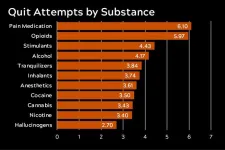(Press-News.org) The subject of when early hominins, closely related ancestors to humans, first left Africa to begin their slow dispersal across the globe is a matter of ongoing discussion among anthropologists. The general consensus has been that hominins were present in Eurasia at least 1.8 million years ago, but some ephemeral traces of hominins have hinted at an earlier presence. New evidence by an international team of researchers now pushes that date back to almost 2 million years ago.
This evidence for hominins in Eurasia earlier than previously thought is based on multiple cut-marked fossil bones from the site of Grăunceanu, Romania. The site of Grăunceanu is found in the Olteţ River Valley along with a handful of other fossil localities. Most of these sites were originally excavated in the 1960s. The absence of hominin bones at the site meant anthropologists had to look for other evidence of hominin presence, such as stone tools or signs of tool use.
More than 5,000 bones from Grăunceanu and surrounding sites were meticulously examined for evidence of cut marks from stone tools used to remove the flesh from animals. Of that total, the team identified at least 20 bones they are confident show signs of cut marks. Biostratagraphic data and high precision uranium-lead dating techniques were used to estimate the age of the bones, which put their minimum age at 1.95 million years ago.
The findings were published in Nature Communications. The international team of more than a dozen researchers was led by Sabrina Curran, an associate professor of anthropology at Ohio University; Claire Terhune, an associate professor of anthropology at the University of Arkansas; and Alexandru Petculescu, of the “Emil Racoviţă” Institute of Speleology in Bucharest.
Terhune noted that the team had to overcome several challenges, including the absence of hominin bones and stone tools at the site. They also had to contend with the fact that the bones were excavated more than 50 years ago, making the relationship of the bones to one another and the exact reasons for their deposition hard to determine. The fossils are currently curated in the “Emil Racoviţă” Institute of Speleology and the Museum of Oltenia. Though researchers had worked with the bones intermittently since their discovery, it was not until the last decade or so that they thought to reexamine them and conduct careful inspections of the surface of each bone.
“We didn’t initially expect to find much,” Curran said. “But during a routine check of the collections we found several cut-marked bones. This led to further investigation in collaboration with Dr. Briana Pobiner of the Smithsonian Institution and Dr. Michael Pante of Colorado State University, and the discovery of other distinct marks across different bones, suggesting deliberate butchering activities.”
Prior to this discovery, the site of Dmanisi in the country of Georgia was thought to contain the oldest evidence of hominin activity outside of Africa, dated to roughly 1.8 million years ago. Confirming the age of the marks establishes both the presence of hominins in Eurasia 200,000 years earlier than previously thought as well as tool use by them, providing some of the earliest evidence of hominin activity in this area.
The team combined this work with isotopic analyses led by Virgil Drăguşin from the “Emil Racoviţă” Institute of Speleology that helped to reconstruct the environment these hominins would have been living in at the time. This work suggests this region would have experienced seasonal fluctuations in temperature, much like today, but that there likely would have been higher levels of rainfall. This would likely have been different from the environments these hominins were originally adapted to in Africa. Analysis of the animal fossils from the site also shows they would have encountered a range of new fauna, including wooly rhinos, saber tooth cats, pangolins and mammoths.
“The field of paleoanthropology can be contentious,” Terhune noted. “People get really fired up about human ancestors, and one ongoing debate has been related to the earliest evidence of tool use. Because of this we have been extremely meticulous in documenting the presence of these cut marks because we knew if we handed another paleontologist these bones, they’d say, ‘Oh, yeah these are cut marks.’ But if we told them they’re from Romania two million years ago, they’re going to say, ‘No, that can’t be right’.”
But the team is confident they got the facts right, and that the discovery is an important step forward.
"The Grăunceanu site represents a pivotal moment in our understanding of human prehistory,” Curran added. “It demonstrates that early hominins had already begun to explore and inhabit diverse environments across Eurasia, showing an adaptability that would later play a crucial role in their survival and spread."
“The history of human evolution is far more complex and intricate than we could have imagined,” she added, “and we are just beginning to uncover the many chapters of that story.”
END
Hominin presence in Eurasia dated to almost 2 million years ago
New findings suggest hominins entered Eurasia roughly 200,000 years earlier than previously thought, predating the Dmanisi site in Georgia
2025-01-27
ELSE PRESS RELEASES FROM THIS DATE:
Researchers uncover new approach to predict pain sensitivity
2025-01-27
In an international effort, researchers at Western University, the University of Maryland School of Dentistry (UMSOD) and Neuroscience Research Australia (NeuRA) uncovered how specific patterns in brain activity can predict an individual’s sensitivity to pain, expanding opportunities for improved pain management strategies.
The new study was published Jan. 27 in JAMA Neurology. It found the combination of two biomarkers in the brain – corticomotor excitability (CME), excitability in the region of the brain that controls movement, and peak alpha frequency (PAF), a neural marker associated with cognitive performance – can accurately and reliably distinguish high- ...
‘Embodied energy’ powers modular worm, jellyfish robots
2025-01-27
ITHACA, N.Y. – In the same way that terrestrial life evolved from ocean swimmers to land walkers, soft robots are progressing, too, thanks to recent Cornell University research in battery development and design.
A modular worm robot and jellyfish demonstrate the benefits of “embodied energy” – an approach that incorporates power sources into the body of a machine, to reduce its weight and cost.
The worm and jellyfish are direct descendants of an aqueous soft robot, inspired by a lionfish and unveiled in 2019, that could store energy and power its applications via a circulating hydraulic fluid – i.e., “robot blood.” Similar blood sustains ...
Hebrew SeniorLife’s Deanna and Sidney Wolk Center for Memory Health recognized as an age-friendly health system
2025-01-27
Hebrew SeniorLife, New England’s largest nonprofit provider of senior health care and living communities and the only senior care organization affiliated with Harvard Medical School, announces that its Deanna and Sidney Wolk Center for Memory Health has been recognized by the Institute of Healthcare Improvement (IHI) as an Age-Friendly Health System, level 2, Committed to Care Excellence.
To qualify as an Age-Friendly Health System, level 2, the Wolk Center, which provides comprehensive outpatient care related to brain health, cognitive and behavioral problems, and memory loss, whether due to Alzheimer’s disease, other dementias, or other neurological or psychiatric ...
Scientists develop ultra-thin absorbers with record-breaking bandwidth
2025-01-27
Absorbing layers have been fundamental to advancements in technologies like energy harvesting, stealth systems, and communication networks. These absorbers efficiently capture electromagnetic waves across broad frequency ranges, enabling the development of sustainable, self-powered devices such as remote sensors and internet of things (IoT) systems. In addition to energy applications, these layers are pivotal in stealth technology, where they minimize radar visibility and enhance the performance of aircraft and naval systems. They also play a crucial role in improving communication networks by reducing ...
Floating solar increases greenhouse gas emissions on small ponds
2025-01-27
ITHACA, N.Y. – While floating solar – the emerging practice of putting solar panels on bodies of water – is promising in its efficiency and its potential to spare agricultural and conservation lands, a new experiment finds environmental trade-offs.
In the first manipulative field study examining the environmental impacts of floating solar, published in Environmental Science and Technology, researchers found that floating solar panels increased greenhouse gas emissions on small ponds by nearly 27%.
“There ...
Cancer risk established before birth
2025-01-27
GRAND RAPIDS, Mich. (Jan. 27, 2025) — A person’s lifetime risk for cancer may begin before they are even born, reports a paradigm-shifting study by Van Andel Institute scientists.
The findings, published in Nature Cancer, identified two distinct epigenetic states that arise during development and are linked to cancer risk. One of these states is associated with a lower lifetime risk while the other is associated with a higher lifetime risk.
If cancer does develop in the lower risk state, it ...
Sinking truths: University of Houston confirms Miami’s coastal subsidence challenges
2025-01-27
On the barrier islands of Miami, 35 skyscrapers – including Trump Tower III - have sunk as much as eight centimeters, or three inches, into the ground since 2016, and researchers from the University of Houston have played a pivotal role in uncovering the reason why – urban development.
The findings, published in Earth and Space Science, reveal alarming rates of subsidence – or land sinking – in coastal structures between 2016 and 2023.
According to the report, "About half of the subsiding structures are younger than 2014 and at the majority of them subsidence decays with ...
Sun receives funding for CyberCorps scholarship for service
2025-01-27
Kun Sun, Professor, Information Sciences and Technology, Center for Secure Information Systems, College of Engineering and Computing (CEC), received funding for: “CyberCorps Scholarship for Service: EAGLE: Empowering American Government Leadership in Cybersecurity through Education.”
Due to the proliferation of cyber-attacks, the ...
If at first you don’t succeed: Virginia Tech researchers ask how many attempts it takes to quit substance abuse
2025-01-27
Relapse is common when someone is trying to quit, regardless of whether they’re giving up opioids or alcohol or cigarettes.
To better inform treatment, researchers with the Fralin Biomedical Research Institute at VTC’s Addiction Recovery Research Center wanted to better understand how the experience of quitting differed across substances.
“When we talk about intervention for addiction, we know that we are far from the ideal model of treatment,” said Rafaela Fontes, a research scientist at the Fralin Biomedical Research Institute and first author on the study, “Beyond ...
Characterizing olfactory brain responses in young infants
2025-01-27
The sense of smell promotes adaptive behaviors such as feeding and soothing, but how early humans begin to process odors represents a gap in knowledge for researchers. In a new study in JNeurosci, Thorsten Kahnt from the National Institute on Drug Abuse and colleagues explored olfaction development in humans and reveal how early humans begin to smell. The researchers used fMRI to image the brains of sleeping infants as they inhaled appetitive (pleasant) and aversive (unpleasant) odors. As early as one month of age, odors triggered activity in brain regions strongly associated ...
LAST 30 PRESS RELEASES:
Post-stroke injection protects the brain in preclinical study
Cardiovascular risk score predicts multiple eye diseases
Health: estimated one in ten British adults used or interested in GLP-1 medications for weight loss
Exercise to treat depression yields similar results to therapy
Whooping cough vaccination for pregnant women strengthens babies’ immune system
Dramatic decline in new cases of orphanhood in Uganda driven by HIV treatment and prevention programs
Stopping weight loss drugs linked to weight regain and reversal of heart health markers
Higher intake of food preservatives linked to increased cancer risk
Mass General Brigham–developed cholera vaccine completes phase 1 trial
First experimental validation of a “150-year-old chemical common sense” direct visualization of the molecular structural changes in the ultrafast anthracene [4+4] photocycloaddition reaction
Lack of support for people on weight loss drugs leaves them vulnerable to nutritional deficiencies, say experts
Dogs’ dinners can have greater climate impact than owners’
Are you ready to swap salmon for sprats and sardines?
1.6 million UK adults used weight loss drugs in past year
American College of Cardiology comments on new dietary guidelines for Americans
American Society of Gene & Cell Therapy and Orphan Therapeutics Accelerator partner to advance and commercialize promising rare disease treatments
One in 14 patients having day case surgery have new or worse chronic pain 3 months after their operation
New study highlights link between eviction rates and gun violence
Heatwaves heat up soil but not toxin levels in rice, study finds
Digital modeling reveals where construction carbon emissions really come from
Turning farm waste into water filters
New study shows how the spleen helps the immune system accept a transplant
New Mayo Clinic study advances personalized prostate cancer education with an EHR-integrated AI agent
Researchers identify novel therapeutic target to improve recovery after nerve injury
Microbes in breast milk help populate infant gut microbiomes
Reprogramming immunity to rewrite the story of Type 1 diabetes
New tool narrows the search for ideal material structures
Artificial saliva containing sugarcane protein helps protect the teeth of patients with head and neck cancer
Understanding the role of linear ubiquitination in T-tubule biogenesis
Researchers identify urban atmosphere as primary reservoir of microplastics
[Press-News.org] Hominin presence in Eurasia dated to almost 2 million years agoNew findings suggest hominins entered Eurasia roughly 200,000 years earlier than previously thought, predating the Dmanisi site in Georgia







